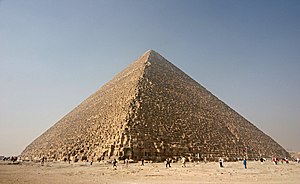 The Great Pyramid of Giza is the oldest and largest of the three pyramids in the Giza Necropolis bordering what is now Cairo, Egypt in Africa, and is the only remaining member of the Seven Wonders of the World. It is believed to have been built as a tomb for Fourth dynasty Egyptian pharaoh Khufu (hellenized as Χεωψ, Cheops) and constructed over a 20 year period concluding around 2560 BC. The tallest structure in the world for over 3,800 years, it is sometimes called Khufu's Pyramid or the Pyramid of Khufu.
The Great Pyramid of Giza is the oldest and largest of the three pyramids in the Giza Necropolis bordering what is now Cairo, Egypt in Africa, and is the only remaining member of the Seven Wonders of the World. It is believed to have been built as a tomb for Fourth dynasty Egyptian pharaoh Khufu (hellenized as Χεωψ, Cheops) and constructed over a 20 year period concluding around 2560 BC. The tallest structure in the world for over 3,800 years, it is sometimes called Khufu's Pyramid or the Pyramid of Khufu.
The Great Pyramid of Giza is the main part of a complex setting of buildings that included two mortuary temples in honor of Khufu (one close to the pyramid and one near the Nile), three smaller pyramids for Khufu's wives, an even smaller "satellite" pyramid, a raised causeway connecting the two temples, and small mastaba tombs surrounding the pyramid for nobles. One of the small pyramids contains the tomb of queen Hetepheres (discovered in 1925), sister and wife of Sneferu and the mother of Khufu. There was a town for the workers of Giza, including a cemetery, bakeries, a beer factory and a copper smelting complex. More buildings and complexes are being discovered by The Giza Mapping Project.
connecting the two temples, and small mastaba tombs surrounding the pyramid for nobles. One of the small pyramids contains the tomb of queen Hetepheres (discovered in 1925), sister and wife of Sneferu and the mother of Khufu. There was a town for the workers of Giza, including a cemetery, bakeries, a beer factory and a copper smelting complex. More buildings and complexes are being discovered by The Giza Mapping Project.
A few hundred metres south-west of the Great Pyramid lies the slightly smaller Pyramid of Khafre, one of Khufu's successors who is also commonly considered the builder of the Great Sphinx, and a few hundred metres further south-west is the Pyramid of Menkaure, Khafre's successor, which is about half as tall.
The generally accepted estimated date of its completion is c. 2560 BC.Although this date contradicts radiocarbon dating evidence, it is loosely supported by a lack of archaeological findings for the existence prior to the fourth dynasty of a civilization with sufficient population or technical ability in the area.
Khufu's vizier, Hemon, or Hemiunu, is believed by some to be the architect of the Great Pyramid.
Monday, September 10, 2007
Free Tour: Great Pyramid of Giza
AT
8:33 am
Label Freeware
Subscribe to:
Post Comments (Atom)
Search
Categories
- Adriana Lima (4)
- Aida Yespica (1)
- Alessandra Ambrosio (1)
- Alessia Ventura (1)
- Alyssa Milano (1)
- Ana Paula Oliveira (1)
- Angelina Jolie (1)
- Anna Kournikova (1)
- Anne Curtis (1)
- Annelyse Schoenberger (1)
- Ayumi Ninomiya (1)
- Baby Spice (1)
- Beverley Mitchell (1)
- Brad Pitt (1)
- Carmen Electra (2)
- Charlize Theron (1)
- Cheryl Tweedy (1)
- Christina Aguilera (1)
- Danielle Lloyd (1)
- Elena Santarelli (1)
- Elisha Cuthbert (1)
- Emily Scott (1)
- Emma B (1)
- Estella Warren (1)
- Eva Longoria (1)
- Eva Mendes (1)
- Federica (1)
- Football (3)
- Freeware (20)
- funny picture (7)
- Game (11)
- Gemma Atkinson (1)
- Gisele Bundchen (2)
- Grace Park (1)
- Happy new year 2008 (1)
- Hayden Panettiere (1)
- Heidi Klum (1)
- Hilary Duff (1)
- Japanese Idol (5)
- Jasmine Lennard (1)
- Jennifer Aniston (1)
- Jennifer Lopez (1)
- Jessica Alba (4)
- Jessica Simpson (2)
- Jun Natsukawa (1)
- Kate Moss (3)
- Keeley Hazell (2)
- Kristin Landen Davis (1)
- Krystal Forscutt (1)
- KT So (1)
- Kuroki Meisa (1)
- Kylie Minogue (1)
- Lee Hyori (1)
- Leeann Tweeden (1)
- Letizia Filippi (1)
- Lindsay Lohan (2)
- Lucy Liu (1)
- Lujan Fernandez (1)
- Make Money (1)
- Maria Ozawa (3)
- Maria Sharapova (1)
- Michaela Stoudkova - Miss Czech (1)
- Michelle Marsh (1)
- Miley Cyrus (1)
- Milla Jovovich (1)
- Miss Earth 2007 (1)
- Miss Rugby (1)
- Miss Universe 2008 - Dayana Mendoza (1)
- Monica Bellucci (1)
- Movie (2)
- Music (3)
- Nereida Gallardo - Cristiano Ronaldo (1)
- Pamela David (1)
- Paris Hilton (2)
- Player of football and girlfriend (4)
- Pussycat Dolls (1)
- Rosaria Cannavo (1)
- Samantha Tajik - Miss Canada 2008 (1)
- Sexy Girl (1)
- Sexy Babe (1)
- Sexy Bikini (8)
- Sexy Clip (4)
- Sexy Girl (16)
- Sexy Teen (36)
- Shakira (1)
- Song Hye Kyo (1)
- Stevi Lauren Perry Miss Teen USA 2008 (1)
- Tata Young (1)
- Thủy Top (1)
- Tila Nguyen (1)
- Uma Thurman (1)
- Ursula Meyes (1)
- Vanessa Marcil (1)
- Veronica Varekova (1)
- Victoria Beckham (1)
- Victoria Secret (1)
- Vida Guerra (2)
- Vivian Hsu (1)
- Yesenia Adame (1)
- Yumi Sugimoto (1)
- Zaira Nara (1)
-
Recent Posts



0 comments:
Post a Comment